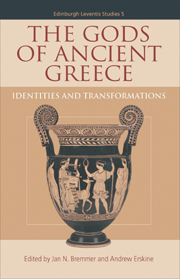Book contents
- Frontmatter
- Contents
- Preface
- List of Illustrations
- Notes on Contributors
- List of Abbreviations
- Introduction: The Greek Gods in the Twentieth Century
- 1 What is a Greek God?
- PART I SYSTEMATIC ASPECTS
- 2 Canonizing the Pantheon: the Dodekatheon in Greek Religion and its Origins
- 3 Gods in Greek Inscriptions: Some Methodological Questions
- 4 Metamorphoses of Gods into Animals and Humans
- 5 Sacrificing to the Gods: Ancient Evidence and Modern Interpretations
- 6 Getting in Contact: Concepts of Human–Divine Encounter in Classical Greek Art
- 7 New Statues for Old Gods
- PART II INDIVIDUAL DIVINITIES AND HEROES
- PART III DIACHRONIC ASPECTS
- PART IV HISTORIOGRAPHY
- Epilogue
- Index
3 - Gods in Greek Inscriptions: Some Methodological Questions
from PART I - SYSTEMATIC ASPECTS
Published online by Cambridge University Press: 05 August 2013
- Frontmatter
- Contents
- Preface
- List of Illustrations
- Notes on Contributors
- List of Abbreviations
- Introduction: The Greek Gods in the Twentieth Century
- 1 What is a Greek God?
- PART I SYSTEMATIC ASPECTS
- 2 Canonizing the Pantheon: the Dodekatheon in Greek Religion and its Origins
- 3 Gods in Greek Inscriptions: Some Methodological Questions
- 4 Metamorphoses of Gods into Animals and Humans
- 5 Sacrificing to the Gods: Ancient Evidence and Modern Interpretations
- 6 Getting in Contact: Concepts of Human–Divine Encounter in Classical Greek Art
- 7 New Statues for Old Gods
- PART II INDIVIDUAL DIVINITIES AND HEROES
- PART III DIACHRONIC ASPECTS
- PART IV HISTORIOGRAPHY
- Epilogue
- Index
Summary
Apuleius' Psyche already knew that dedicatory inscriptions were the quickest way to learn who the divine incumbent of a sanctuary was – most dedications addressed the main divinity worshipped in a sanctuary, so she quickly identified Juno as the incumbent of a sanctuary she stumbled upon. From their study of a growing number of ancient objects, Renaissance antiquarians were familiar with the combination of a divine image and a dedicatory inscription on its base, and the author of the Hypnerotomachia Poliphili, among other things a delightful document of early Renaissance antiquarianism, invented such epigraphical monuments of divinities that were relevant to his story. In the study of ancient gods, however, inscriptions rarely played a large role. Historians used epigraphical evidence mainly when describing local cults: well before Lewis Farnell (1856–1934) in his Cults of the Greek States printed the relevant epigraphical texts among his references, scholars such as Sam Wide (1861–1918) combined epigraphy with the literary and archaeological evidence. But not being epigraphers, these authors used inscriptions mostly in a rather cursory fashion, and since many of these monographs were written in the late nineteenth century, before the collection of the Inscriptiones Graecae were available, their usefulness is rather limited nowadays. No scholar, as far as I know, has looked at the Greek gods uniquely through the lens of a corpus of evidence characterized by its material conditions only, instead of its content or literary genre.
- Type
- Chapter
- Information
- The Gods of Ancient GreeceIdentities and Transformations, pp. 55 - 80Publisher: Edinburgh University PressPrint publication year: 2010



